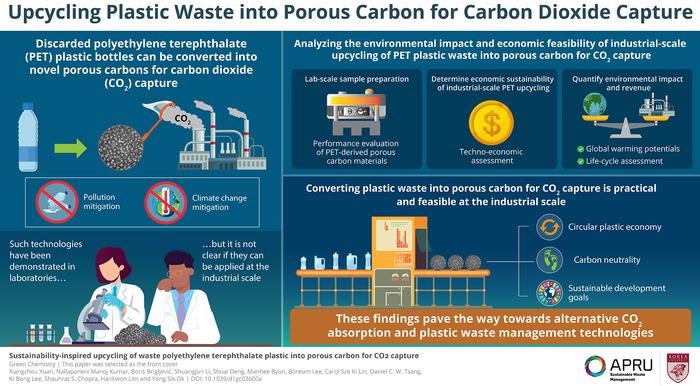Plastic pollution is one of the most serious environmental concerns of this decade, aside from climate change, which is largely caused by carbon dioxide (CO2) emissions.
 PET bottles are a major and ubiquitous source of plastic pollution. However, emerging technologies can turn them into porous carbon materials for carbon capture and storage systems. Now, researchers from Korea University demonstrate an economically feasible of doing so. Image Credit: Shutterstock
PET bottles are a major and ubiquitous source of plastic pollution. However, emerging technologies can turn them into porous carbon materials for carbon capture and storage systems. Now, researchers from Korea University demonstrate an economically feasible of doing so. Image Credit: Shutterstock
The massive amount of discarded and misplaced plastic is wreaking havoc on Earth’s ecosystems, affecting crops and contaminating water supplies. It is vital to find efficient ways to repurpose discarded plastics to transition into a truly sustainable society. But what if it is possible to fight fire with fire, or carbon with carbon, in this case?
Carbon capture technologies are on the continuous rise, and so plastic waste-derived porous materials that have the ability to adsorb CO2 from flue gas are considered an appealing option to concurrently decrease CO2 emissions and plastic pollution.
The majority of the well-known materials for CO2 capture are expensive to use and produce; affordable porous carbon could be synthesized from polyethylene terephthalate (PET) plastic bottles. This is a significant source of plastic pollution throughout the world.
Several routes and methods of synthesis have been illustrated at a laboratory scale on this front. However, it is not yet evident how well these methods could be upscaled for industrial-scale applications while taking economic feasibility and environmental benefits into account.
An international group of scientists headed by Professor Yong Sik Ok and Dr. Xiangzhou Yuan of Korea University sought to identify if PET-derived porous carbon can truly be made feasible in sustainable large-scale CCS systems from practical, economic and environmental standpoints.
The primary steps in establishing an emerging technology involve the synthesis and simulation of its processes outside the laboratory in order to justify its improved sustainability and cost-effectiveness over more established techniques.
Xiangzhou Yuan, Korea University
In the study that was featured on the front cover of the journal Green Chemistry, the researchers went after three major objectives: assessing the performance of various PET-derived porous carbon materials at the lab scale, identifying if such materials could be beneficial in economically sustainable industrial-scale processes, and measuring the environmental impact of each method.
This work was performed in collaboration with scientists from other institutions, including Professor Hankwon Lim of Ulsan National Institute of Science and Technology, Korea, and Professor Shauhrat S. Chopra from the City University of Hong Kong, China.
Initially, the team collected thrown-away PET bottles and processed them in various methods to synthesize three kinds of porous carbon materials. Through lab-scale experiments, the researchers examined the morphology, composition and performance of these three materials to collect useful data for following industrial-scale numerical simulations.
For such simulations to be performed, the researchers modeled the complete process, from the grinding and transportation of PET bottles and the synthesis of porous carbon to the clean flue gas output. This includes secondary systems to generate electricity utilizing waste heat.
Lastly, they compared the economic viability and environmental impact of the synthesis pathways of the three PET-derived porous carbon materials to evaluate the extent of climate change mitigation and revenue production (from selling the material and the electricity generated) from every material.
Depending on the overall results, the researchers concluded that CO2 capture systems utilizing PET-derived porous carbon could realize plastic and carbon closed loops in industrial-scale applications. These multi-purpose systems could become a feasible alternative to both conventional CO2 capture and plastic waste management technologies.
Also, the findings of this study could help direct the decision-making process of early adopters and policymakers similar.
Most significantly, the suggested synthesis routes exhibit the great potential to fulfill the sustainable development goals (SDGs) proposed by the United Nations.
The upcycling of plastic waste-derived porous carbon for CO2 capture is a promising approach to meet multiple SDGs since it can mitigate climate change and plastic pollution simultaneously, and facilitate sustainable recycling of discarded PET plastic bottles in urban areas.
Yong Sik Ok, Professor, Korea University
Journal Reference:
Yuan, X., et al. (2022) Sustainability-inspired upcycling of waste polyethylene terephthalate plastic into porous carbon for CO2 capture. Green Chemistry. doi.org/10.1039/D1GC03600A.
Source: https://cactusglobal.com/